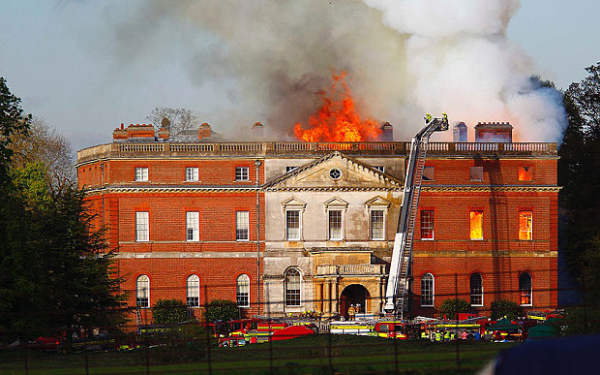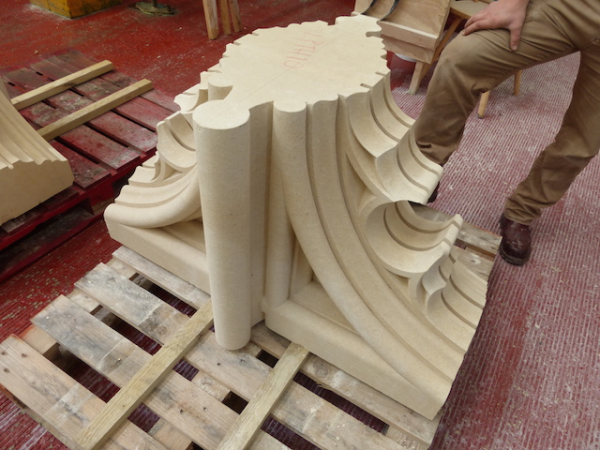Fire Damage in Historic Buildings.
Fire in historic houses has hit the headlines a number of times already this year. The most recent being a devastating fire at the National Trust's Clandon Park just this week. We are members of the National Trust and have visited Clandon many times so we are very sorry to hear the news.

Image courtesy of telegraph.co.uk
Once the fire has been put out and the damage is assessed, thoughts quickly turn to the restoration of the building. It had not previously occured to me that a fire could cause so much damage to the core structure of a stone building. Of course we expect that a timber house would be more seriously damaged than one built in stone but it is easy to forget that most stone houses would also have had a timber frame.
We have recently been asked to source replacement stone for a severely fire damaged historic house in the East of England. The house had features made from French limestone, a pale stone from Caen, Lower Normandy.
Caen stone was used in many historic buildings in England thanks to William the Conqueror, who favoured it over 'Saxon' stone. Canterbury Cathedral, Westminister Abbey and the Tower of London, among others, were all originally built using the white Caen limestone. Hence the Tower of London became known as 'The White Tower'.
English Heritage and Conservation Officers are usually keen to see like for like replacement of stone wherever possible. Striking the balance between historical accuracy and the future durability of the building can be challenging. In some cases it is not possible to replace stone with exact like for like because the quarry has closed or no longer produces stone with the same characteristics.
Often we have a tendency to look back on historic buildings with a sense of nostalgia and romance which leads us to assume that the best materials and construction methods were always used. However, we know that sometimes materials were chosen simply because they were readily available. Why would you use a hard stone from further afield which you would have to transport at great expense and effort when you could use the stone right under your feet?
 A clear example of this is in the village of Le Puy Notre Dame, the Loire Valley, where we have recently bought a house to renovate. Our little house, just like all the others in the area, was built out of the local Tuffeau stone, a pale sedimentary rock that is very soft and weathers easily. Over the centuries, the stone was quarried out from under the village, leaving a vast network of tunnels and caves which are still used for wine making. There was such an abundance of this easily quarried stone that it is no wonder everyone built their house with it.
A clear example of this is in the village of Le Puy Notre Dame, the Loire Valley, where we have recently bought a house to renovate. Our little house, just like all the others in the area, was built out of the local Tuffeau stone, a pale sedimentary rock that is very soft and weathers easily. Over the centuries, the stone was quarried out from under the village, leaving a vast network of tunnels and caves which are still used for wine making. There was such an abundance of this easily quarried stone that it is no wonder everyone built their house with it.
To compensate for the Tuffeau being soft, old houses were built using large blocks. In conjunction with a timber frame, earth floors and lime plaster, the houses were completely breathable. Provided that this level of ventilation and breathability was maintained, the buildings would have been sufficiently durable. Problems arise when smaller blocks have been used as cheaper replacements and concrete render and mortar has been applied in recent years. Modern methods of insulation and the overuse of concrete causes damp to become concentrated in parts of the building which rapidly speeds up the degradation of the stone.
Just an hour or so north of Le Puy and you enter the Mayenne where houses are predominantly built from grey granite... Quite a different story when it comes to maintenance work. Although it has to be said that the constant repair and replacement of the Loire Tuffeau creates plenty of work for local stone masons!
So in situations where the original stone is no longer available or where an alternative can be found that will perform better in a modern environment than the original, there may be more suitable options than simply to replace like for like.
The restoration project that I mentioned earlier falls into this category. We have been able to source a replacement for the original Caen stone that is almost identical visually but will be more durable for use on the exterior of the buildings. The same stone is being used in Canterbury Cathedral and other significant buildings as a substitute for Caen stone. You can explore more French limestone on our web page. We have contacts with specialist heritage expertise in the French limestone quarries and they are often called on to help with British restoration projects.

In this article, I have primarily talked about the use of natural stone as a building material. However, many historic houses used exotic marbles for decorative purposes that the owners found on their travels, for example, while on The Grand Tour. In these cases, spectacular marbles and semi precious stones were used in the form of fire surrounds, columns, carvings, intricate floor designs, etc. to display wealth and to impress distinguished visitors. Sometimes the houses have records of which type of marble was used but often a bit of detective work is required.
 Sourcing replacement stone for restoration work is one of the most exciting areas of our business and we really enjoy the challenge. Other projects that we have previously worked on include creating exact reproductions of original fire surrounds, sourcing an exact match for a Victorian chequerboard marble floor, and even creating a full scale replica of the Vence Chapel by Matisse for a private customer (see image). We have some photos of these projects and others on our Houzz page.
Sourcing replacement stone for restoration work is one of the most exciting areas of our business and we really enjoy the challenge. Other projects that we have previously worked on include creating exact reproductions of original fire surrounds, sourcing an exact match for a Victorian chequerboard marble floor, and even creating a full scale replica of the Vence Chapel by Matisse for a private customer (see image). We have some photos of these projects and others on our Houzz page.
As members of the Stone Federation of Great Britain, we have the support of their team of experts who have a wealth of experience in working on historic buildings and important restoration projects. We are also accredited installers for Fila Solutions, the leading manufacturer of specialist sealers and cleaners for natural stone.
If you would like to talk to us about your project or if you have any queries on this subject, please feel free contact us and we will be happy to help.
If you would like to know more about how we source natural stone for projects, please download our brochure:
Thanks for reading.
Katie Turner
Amarestone
Tel: 0345 260 8070
Email: katie@amarestone.com
P.S. - get the next blog direct to your inbox by entering your email address in the box on this page.
Did you find this useful or interesting? Click the "Share" button and tell your network.


